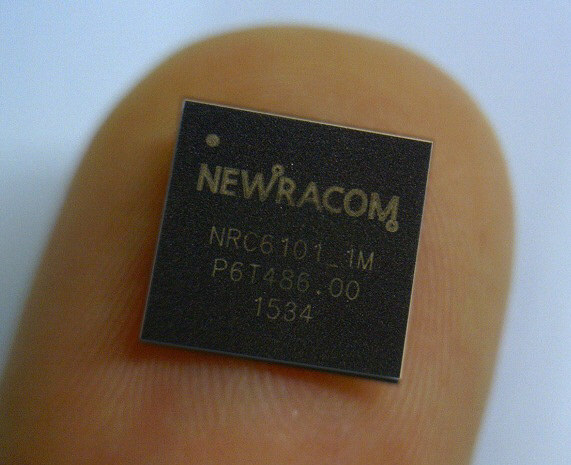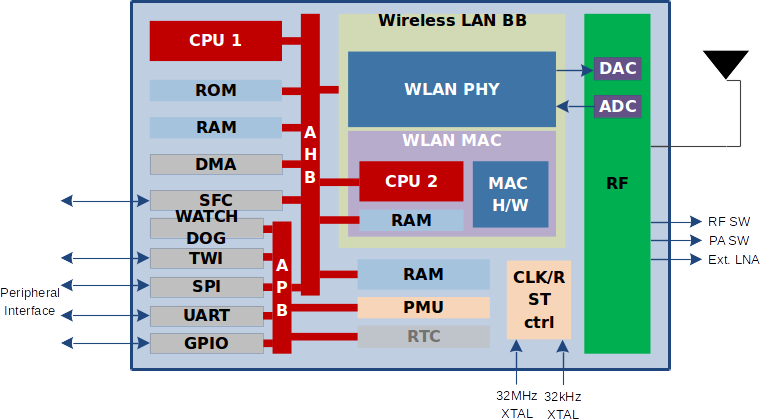802.11ah is a new WiFi standard operating in the 900 MHz range that targets low power & long range connectivity, as required by many IoT & M2M applications. According to this low power WAN standards comparison table, 802.11ah also supports up 1km range outdoor, 150 Kbps to 346 Mbps transfer rates, up 8191 clients per access points, and a 2016 launch is planned. However, I had not seen any implementations based on the new standard, except a demonstration by Antcor on a DSP in 2014. A Korean startup, Newracom, may however soon launch the first 802.11ah chip with NRC6101 SoC.

I was tipped about this new solution via a Korean website, where I got the picture above from, but there’s no information about NRC6101 on the web, except for a small mention on Wikidevi.com redirecting to the product page, where NRC6101 name is not even mentioned, but with some specifications for a 802.11ah SoC:
- IEEE802.11ah
- Single stream up to 2.167Mbps data rate
- Data symbol block-wise repeated for increasing the reliability
- Supports 1 and 2MHz channel bandwidth with optional Short Guard interval
- Support TWT (Target Wake Time) function for power saving
- SoC
- Multi cores SoC system with dual ARM processors
- Low Power processor (Main CPU) for application software
- Low Power processor (WLAN CPU) for WLAN software
- BUS System supports 2-Layer and Full Matrix AHB
- Low Power Design
- Multi cores SoC system with dual ARM processors
- Benefits – Wide range, Low power Wi-Fi solution is available for not only SoC but also reusable IP
- Physical Interfaces / Peripheral – I2C, HSUART, UART, SSP, SPI

So they’ve adopted a dual core micro-controller structure, with one core dedicated to WiFi, and the other used by the application software, similarly to what has been done for the upcoming Espressif ESP32. The main target applications include smart grid and extending “Wi-Fi” coverage, but the solution could also be used for remote controls, home/office automation devices, or industrial automation.
I could not find further details with regards to availability, pricing, and eventual development kits. Newracom will showcase their solutions at IP SoC 2015 conference on December 2-3 in Grenoble, France.
Thanks to Nanik for the tip.

Jean-Luc started CNX Software in 2010 as a part-time endeavor, before quitting his job as a software engineering manager, and starting to write daily news, and reviews full time later in 2011.
Support CNX Software! Donate via cryptocurrencies, become a Patron on Patreon, or purchase goods on Amazon or Aliexpress





This looks exciting but the main problem I see here is that this needs additional equipment for a home user. While ESP8266 can just connect to the router you have in the house this one will need a new access point. Other than that it’s perfect for home sensors if it comes at a good price.
Looks like LoRa, 802.11ah etc are all trying to get to market in a hurry before Bluetooth Mesh comes into play next year.
The problem with 802.11ah is that it seems to use something like 10 different frequencies, as per http://www.cnx-software.com/2014/02/21/802-11ah-wi-fi-900-mhz-to-provide-low-power-long-range-connectivity-for-the-internet-of-things/
This is going to be a real pain, as it would be impossible to make a single good antenna from 755-928MHz, so there will at least be three product SKU’s, i.e. China, Europe/Singapore and US/Japan/Korea, with Australia/New Zealand most likely doing their own thing as with Z-Wave and the same going for Russia Israel, India etc.
802.11ah doesn’t really solve any problems, it does however add problems and for most consumers, it’ll just be confusing as it’s not compatible with “normal” Wi-Fi.
It will end up like Zwave since Zwave operates in the same bands. With Zwave you need six different module variations to cover most of the world. Those six modules are all made with the same footprint and you solder on the right one for the region you are shipping too. The modules all contain spring antennas soldered to the PCB since the antennas are all slightly different lengths.
http://www.marketwired.com/press-release/sigma-designs-unveils-full-suite-of-z-wave-next-gen-chips-and-modules-nasdaq-sigm-1777162.htm
Personally I think 802.11ah is pointless. I don’t know why it was put under the 802.11 family banner, probably politics.
John Smirl/TLS : They won’t care. Most of the IoT type space this is aimed at is in the Oil Patch and they’re looking for better answers in the ISM bands in question. This isn’t for consumers, unless someone goes and does something with it. This is for industrial automation in the energy production space and similar. (Hint: Not all embedded stuff is for consumer uses, unless you grab some of this stuff and DO it that way… >:-D)
BT Meshing won’t help this story either. When your story is kbps to Mbps, you’re not talking home automation (though I could see someone TRYING with that- because even though there’s 4-5 differing bands for homologation, it’s got range that BT, WiFi, and the like DO NOT HAVE. 2.4 GHz has screwy propagation behaviors over 900MHz- which is the other ISM license-free band region. 900MHz will reach MILES on only a couple of watts and a good 6dB gain antenna. 900MHz will go 80-120 nautical miles with the right antennas and booster on one end of the link. The same can’t be said for WiFi in any of it’s bands, BlueTooth, 6LowPan, etc.
While they have made impressive long-range demonstrations with 2.4 GHz WiFi, 80 or so Nautical, it required *REALLY* special gear, including a dish the size of a C-Band satellite receiver on both ends. 900MHz? Just good High-Gain antennas (~12-24 dB yagi’s) coupled with about 5 watts of power.
6lowpan is a protocol. It works on 900Mhz, 802.15.4, BLE radios or even Ethernet. 6lowpan does not specify a PHY layer.
Why do we need yet another 900Mhz radio layer? We already have about a hundred of them.
@Jon Smirl
> “Why do we need yet another 900Mhz radio layer? We already have about a hundred of them.”
=> https://imgs.xkcd.com/comics/standards.png
they should go even lower freq, e.g. 433Mhz or even 3XXMhz, for real long-distance, as data-payload is light for IoT/M2M application, TI does this long time ago, it’s just not “standardized”
Quite a while back I was trying to solve a problem relating to no broadband access in a remote uphill region in the north of Thailand..the answer I got from 2-3 ISPs in that are was because the premises lies in a border province area they really cannot extend to last mile connection(s) so the need of a relay instrument via which I was hoping to provide internet access..this looks interesting if it’s cheap enough to setup otherwise one the ISP was ready to setup a receiver high gain antenna setup for about 30k thai baht and separate monthly fees 😐
ISM is out the question due to low speeds / WiMax as well